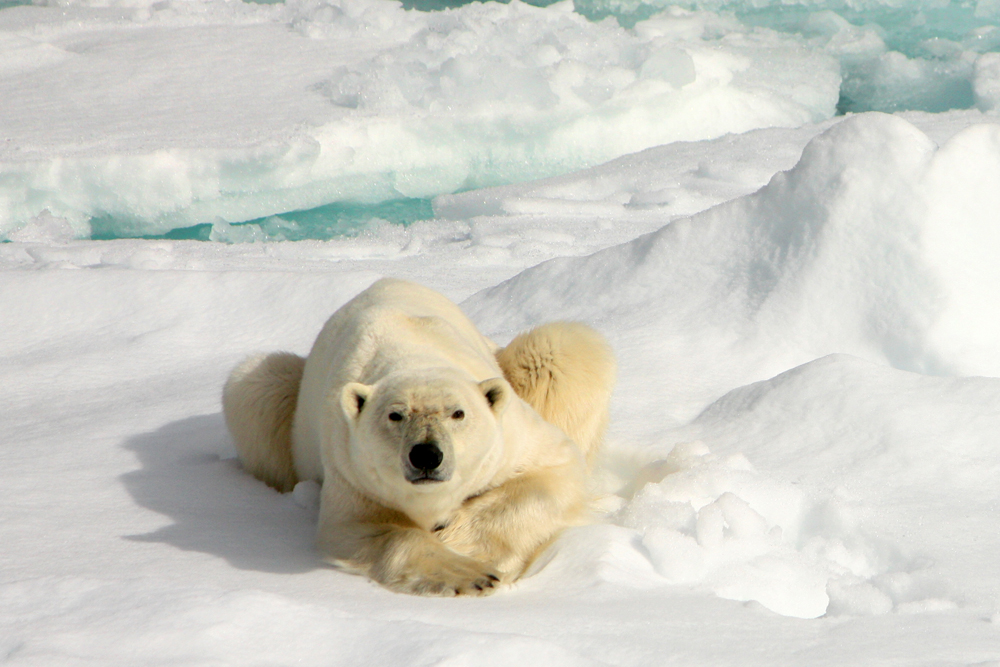Antarctica Cruises: Insider’s Guide
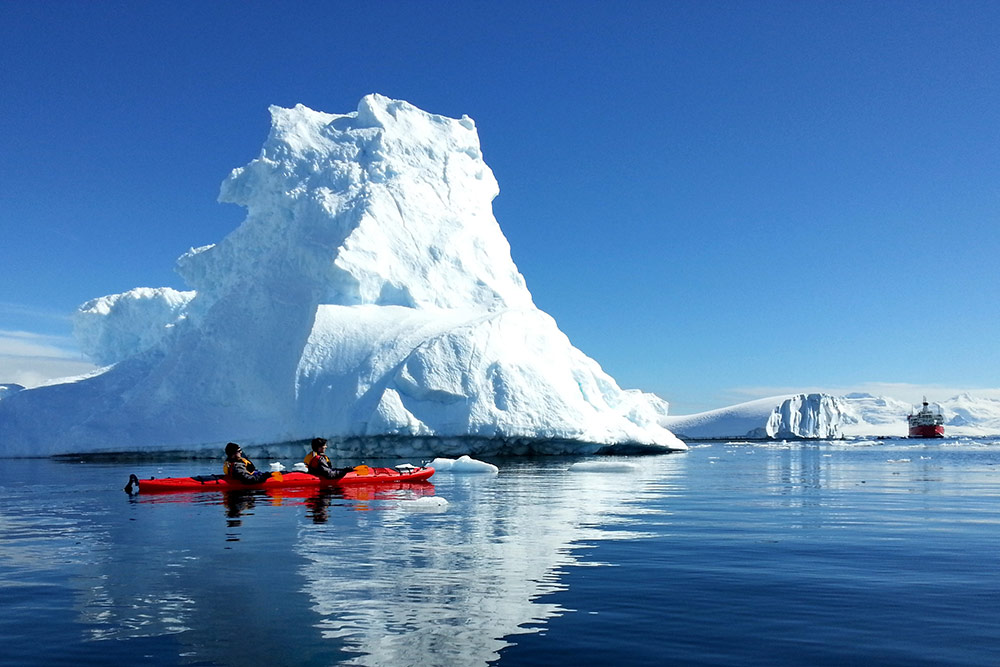 An iceberg kayaking expedition. Photo by Sherry Ott/Ott's World.
An iceberg kayaking expedition. Photo by Sherry Ott/Ott's World.
The insider advice on this page is from one of Wendy’s Trusted Travel Experts for Antarctica and expedition cruises: Ashton Palmer of ExpeditionTrips.
Infectiously enthusiastic about small-ship cruising, Ashton spent nearly a decade as an expedition leader, guide, naturalist, Zodiac driver, avid bird-watcher, and photographer in the Arctic, Antarctica, the Amazon, and the South Pacific. (He has traveled to Antarctica more than 50 times and spent a collective three months in the Arctic.) In 1999, Ashton started a company to match travelers with the right small-ship expedition trips everywhere from the Galapagos to Papua New Guinea and the two poles. He’ll be the first to tell you when a two-week trip to the Arctic may not be your cup of tea, and when a specific ship or cabin just isn’t worth the extra expense. And because of his relationships with the top cruise lines and tour operators, Ashton often secures preferred rates or other perks (such as shipboard credits or a bottle of wine).
Ships and Cruises
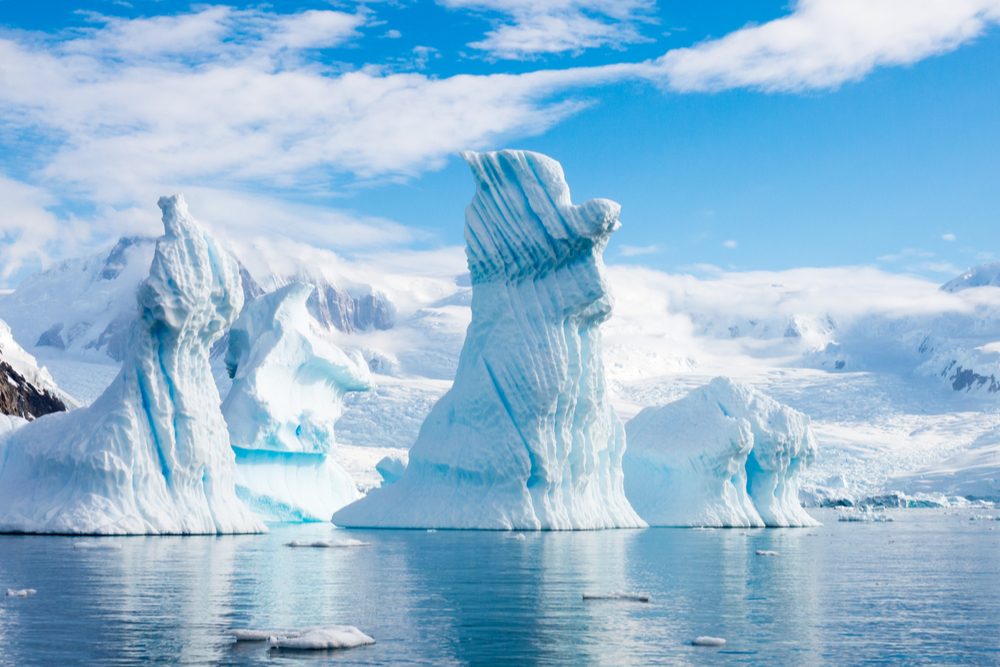
Pinnacle shaped icebergs floating in Andvord Bay near Neko Harbour, Antarctic Peninsula, Antarctica. Photo: Shutterstock
Best-value ships
Quark’s Ocean Adventurer (128 passengers) and World Explorer (178 passengers) are classic expedition ships that offer consistently great trips. Ashton has worked with these ships for 20 years because they provide adventurous itineraries at a really good price point. (You want to snowshoe? Check. Want to sea kayak? Check.) To max out the bang for the buck, take advantage of early-booking discounts; if you are traveling solo, you can choose to share a cabin with another cruiser and avoid paying a single supplement.
Ships worth the splurge
Seabourn’s sister ships Venture and Pursuit are brand-new, having just launched in 2022 and 2023 respectively. These beauties are ultra-luxury ships with an adventure focus; each carries 268 passengers and every single cabin has a veranda. There are multiple excellent dining options, two on-board submarines, ample Zodiacs and kayaks, and a 26-person expedition staff.
Best expedition ships
Lindblad’s National Geographic Resolution and National Geographic Endurance each carry 128 passengers and feature thoughtful Scandinavian design to ensure your attention goes past the windows to the scenery.
A great mid-range option is Quark’s Ultramarine, a beautiful 199-passenger ship with two helicopters on board.
Best ships for foodies
For those who want to eat really, really well, the Scenic Eclipse and soon-to-be-launched Scenic Eclipse II (both carrying 228 passengers) offer ten culinary styles, including an upscale French restaurant and Champagne bar, Asian fusion, sushi, a night-market bar, a casual yacht club, a chef’s tasting table, private dining, and even culinary master-classes. (And they are all-inclusive.)
Also notable for gastronomy is Ponant’s Le Commandant Charcot (270 passengers), the only ship that has a restaurant from Michelin-starred chef Alain Ducasse; there will be plenty of caviar onboard—and if you like Champagne, their house pour is Veuve Clicquot.
Best sailing for families
While Antarctica is a destination that tends to appeal more to adults than young children, Ponant’s Le Boréal (200 passengers) operates an annual family sailing to Antarctica, the Falklands, and South Georgia over the December holidays with dedicated children’s-activity coordinators. Kids are up to 50 percent off, and the ship has a variety of cabin configurations that lend themselves well to families (including quads and triples).
Best ships for solo travelers
Sister ships Le Boreal, L’Astral, Le Lyrial, and Le Soleil frequently waive solo supplements because they limit capacity to 200 in polar regions but can carry more passengers.
The Ultramarine has possibly the nicest solo cabins available.
Best ships for active adventures
You can tell that Aurora’s two ships, the Greg Mortimer and the Sylvia Earle, prioritize adventure based on their namesakes, the first Australian to climb Mt. Everest without oxygen and the woman who holds the record for the deepest ocean-floor walk. These ships carry 132 passengers and focus on activities such as kayaking, camping, snowshoeing, scuba diving, and polar snorkeling.
Explorer types should also consider the Base Camp Antarctica program offered on the M/V Hondius (170 passengers), M/V Ortelius (116 passengers), and M/V Plancius (116 passengers) where the vessels stay in one location for longer periods to maximize time camping, hiking, kayaking, and mountaineering.
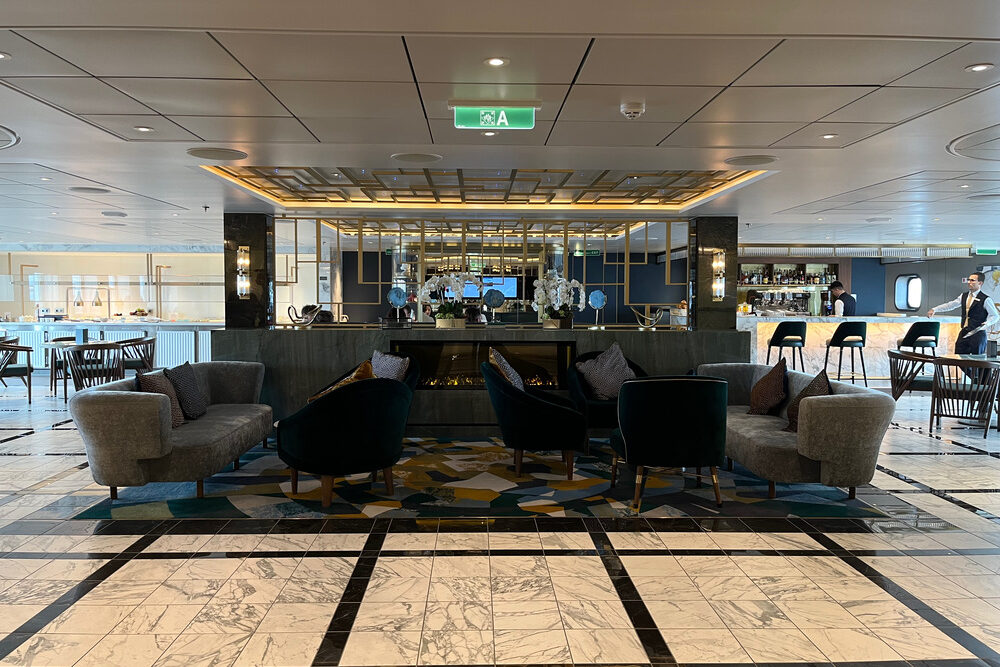
The Arts Cafe on Silver Endeavour, with its crackling faux fireplace, bar that serves everything from hot tea to Champagne, and an array of hot and cold comfort dishes, was our favorite go-to on busy expedition days on Silver Endeavour. Photo: Carolyn Spencer Brown.
Cabins worth the splurge
Silversea’s Silver Endeavour (200 passengers) is probably the most luxurious ship in Antarctica, and its best cabin is the Owner’s Suite, measuring 1876 square feet with a wraparound verandah and a premium bow position on deck 7; it’s a cool $100,000 for Antarctic voyages. Or choose Le Commandant Charcot’s Duplex Suite, which even has a private hot tub on the lower patio. The Wintergarten Suite on the Venture is also a two-level, apartment-style stateroom with a sculptured staircase cascading down in front of two-story windows.
Where to Cruise
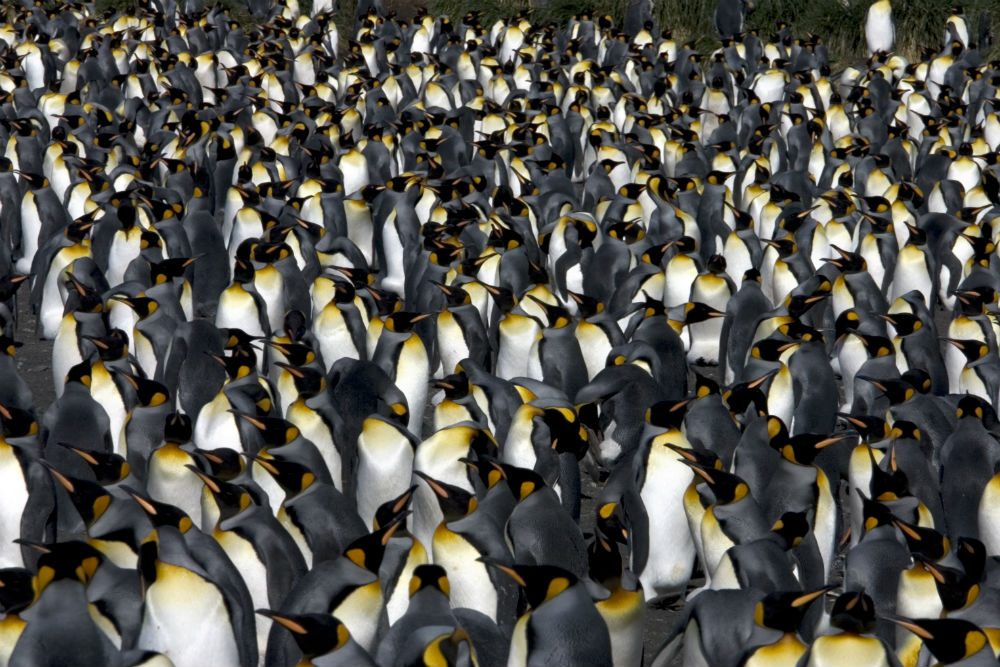
King penguins, South Georgia Island. Photo: ExpeditionTrips
Best itinerary
The best trips include South Georgia Island, where you can see wildlife species in ridiculous abundance. This island is very different from the Antarctic continent. South Georgia is like the Swiss Alps—with snow-capped peaks and green valleys—but teeming with wildlife. Because South Georgia doesn’t become icebound in the winter and is uninhabited by people, the native species can live here year-round. The rugged coastlines are home to massive colonies of king penguins (the ones with orange and yellow markings on their beaks and necks), as well as hundreds of baby fur seals that nest in the green tussock grass. Disembarking a Zodiac and walking onshore with tens of thousands of king penguins is an experience you cannot have anywhere else on the planet.
Cruises that include South Georgia Islands usually run 17 to 25 days, and most ships operate only one or two such itineraries per season, typically in December and January. Ashton does not recommend shorter trips that include South Georgic, as they cut out time in Antarctica. The very best itinerary is the comprehensive 24-day voyage on the National Geographic Endurance or the National Geographic Resolution, which includes five full days in Antarctica and adequate time exploring the sub-Antarctic islands. Since there are limited departures, Ashton recommends booking this trip at least 18 months in advance
Best short cruise
Trips of at least 11 days are optimal, but travelers pressed for time have an increasing number of “air-cruise” options: Vessels such as the World Explorer (140 passengers) and the Magellan Explorer (73 passengers) offer six- and eight-day itineraries where you fly over the Drake Passage from Punta Arenas, Chile (rather than sailing from Ushuaia, Argentina) and board the ship on King George Island. The expected time in Antarctica is three or four days, but flights are dependent on weather conditions and are occasionally delayed.

A Zodiac cruise. Photograph by Abby Suplizio.
Don’t miss
Exploring Paradise Bay via Zodiac or sea kayak. Nothing quite compares to gliding along glasslike water, surrounded by sculptural, bright-blue icebergs and crisp white peaks. If you’re lucky, you may even see a few whales.
Port most worth the trek
Prion Island, a tiny islet off South Georgia Island, is one of the few places on the planet where you can come face-to-face with a wandering albatross on the nest. This magnificent species has the largest wingspan of any living bird, ranging from eight to 12 feet, and can weigh up to 30 pounds.
When to book your cruise
Try to book your Antarctica expedition approximately 18 months prior to departure. Itineraries and rates are typically released in June or July (of the previous year), which is when you’ll find early-booking discounts and prime-cabin availability (the least expensive and most expensive cabins sell out first).
Best Times to Go

The Antarctic season is November through February. The snow and ice are at their most pristine in November or early December. For wildlife, the very best time to go is the latter half of December; by then, thousands of penguins, including their fluffy chicks, have made their home along the coastline. The sea ice has usually broken up enough to allow great access, and December and January (middle of the austral summer) offer the likelihood of better weather. February is best for whale watching, because the sea ice has fully melted, allowing the migratory whales to surface and feed.
Worst Times to Go
March. Most penguins have fledged, the rookeries are extremely soiled, and inclement weather becomes more likely.
If seeing penguin chicks or whales is important to you, also avoid November, as it is too early in the season.
Biggest Rookie Mistakes
Selecting an itinerary that’s too short. A trip to Antarctica is an investment of not just money but also time. It takes several days to reach the continent (including crossing the Drake Passage), and because of unpredictable sailing conditions, an extra two to four days can make a significant difference in your experience. Eleven-day itineraries provide a cushion for challenging weather conditions and ease you into the trip. I’d also encourage you to build in an extra day or two to relax when you arrive in Argentina or Chile (the usual points of embarkation) so that you’ll be refreshed and more present with the experience once you reach Antarctica. I have never met anyone returning from the Great White Continent who complained that the trip was too long—rather, people wish they had more time.
Best Shore Excursions
By and large, all shore excursions are included in expedition-style cruising. The whole point of going all this way is to set foot on the continent of Antarctica (amid thousands of friendly penguins), and all of the expedition ships deliver on that experience. Unique excursions include exploring underwater by submersible aboard the Scenic Eclipse or Seabourn Venture, camping overnight on the continent of Antarctica, or getting an aerial view of the white continent by helicopter aboard the Ultramarine or Scenic Eclipse.
Worst Shore Excursion
There really are no bad shore excursions in Antarctica. But don’t feel bad about skipping the “polar plunge” into frigid Antarctic water, because it’s just really, really cold!
Instagram Moment
Polar glamping is now a thing. You can sleep in a transparent igloo on the deck of the National Geographic Endurance or National Geographic Resolution, where they are tucked away on the back deck next to the hot tubs. The igloos are available to spend time in during the day, or you can reserve them overnight to watch the changing sky and polar scenery until you fall asleep, snuggled in with cozy comforters and hot water bottles.


